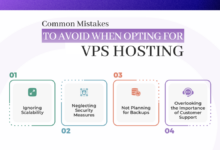How to Choose the Best VPS Hosting Provider for Your Needs
How to Choose the Best VPS Hosting Provider for Your Needs is a crucial decision for anyone looking to host a website or application. Selecting the right provider can significantly impact your website’s performance, security, and overall success. This guide will walk you through the essential steps, from understanding your specific needs to evaluating provider reliability and scalability, ensuring you make an informed choice that aligns perfectly with your goals and budget.
We’ll explore key factors like server location, uptime guarantees, customer support responsiveness, and pricing models. We’ll also delve into the importance of robust security features, scalability options, and the intricacies of Service Level Agreements (SLAs). By the end of this comprehensive guide, you’ll be equipped with the knowledge to confidently choose a VPS hosting provider that meets your current and future requirements.
Understanding Your Needs
Choosing the right VPS hosting provider hinges on a thorough understanding of your website’s specific needs. Failing to accurately assess these requirements can lead to performance issues, unexpected costs, and ultimately, a less-than-optimal online experience for your users. Before you begin comparing providers, take the time to carefully analyze your current and future demands.
Choosing the right VPS requires a careful assessment of several key factors. This involves understanding your website’s resource consumption, the applications you’ll be running, and your budgetary considerations. Accurate planning in these areas will ensure a smooth and efficient transition to a VPS environment.
Website Requirements
Your website’s performance is directly tied to the resources allocated to it. High-traffic websites, for example, require significantly more processing power, memory, and bandwidth than low-traffic blogs. Consider your average monthly visitors, peak traffic periods (e.g., during sales or marketing campaigns), and the size of your website’s files. A small business website with a few hundred visitors per month will have vastly different needs compared to a large e-commerce platform handling thousands of concurrent users. For instance, a website averaging 10,000 visitors per month with large images and videos will require a more robust VPS plan than a simple informational site with only text and small images. Accurate estimation of these metrics is crucial for selecting an appropriate VPS plan.
Application Types
The applications you run on your VPS will heavily influence your resource requirements. Resource-intensive applications such as database servers (MySQL, PostgreSQL), gaming servers, or video editing platforms demand significantly more CPU power, RAM, and storage than simpler applications like a basic WordPress blog. For example, running a resource-intensive application like a custom-built e-commerce platform with a large database and numerous user interactions will necessitate a VPS with higher specifications compared to hosting a simple static website. Understanding the specific demands of your applications is vital for ensuring optimal performance and stability.
Budget and Scaling
Your budget dictates the level of resources you can afford. VPS plans vary widely in price, depending on the resources they offer. It is important to balance your budget with your website’s needs. Furthermore, consider your long-term scaling plans. Will your website’s traffic increase significantly in the future? If so, choose a provider that offers easy scalability and upgrade options to avoid costly migrations or performance bottlenecks later on. For example, a startup expecting rapid growth should prioritize a provider with flexible scaling options, while a well-established business with stable traffic may opt for a more cost-effective long-term solution.
Comparing VPS Hosting Features
Choosing the right VPS hosting provider involves careful consideration of several key features. Understanding the differences between various VPS types and the impact of server location is crucial for optimizing performance and cost-effectiveness. This section will guide you through comparing these critical aspects.
VPS Types: Managed vs. Unmanaged, Windows vs. Linux
Managed VPS hosting provides a higher level of support, with the provider handling server maintenance, security updates, and other administrative tasks. This is ideal for users who lack the technical expertise to manage a server themselves. Unmanaged VPS hosting, on the other hand, offers greater control and flexibility but requires more technical knowledge and hands-on management. The choice depends on your technical skills and comfort level.
Windows VPS hosting offers familiarity for users accustomed to the Windows operating system and its associated software. It’s often preferred for applications requiring specific Windows-based software or technologies. Linux VPS hosting, conversely, is generally more cost-effective and offers a wider range of customization options, making it a popular choice for developers and those prioritizing flexibility and control. Linux servers are also often seen as more secure.
Server Location and Latency
The physical location of your VPS server significantly impacts latency, which is the delay in data transmission. A server closer to your target audience will generally result in faster loading times and improved user experience. Choosing a server location within the same region or continent as your users is often the best approach for minimizing latency. For example, a business targeting customers primarily in Europe should consider a European-based server. Conversely, a company with a global customer base might benefit from a Content Delivery Network (CDN) to distribute content across multiple server locations.
Comparison of Key Features Across Popular Providers
The following table compares key features of some popular VPS hosting providers. Note that pricing and specific configurations can vary, and this table represents a snapshot in time. It’s crucial to check the provider’s website for the most up-to-date information.
| Provider | RAM (GB) | CPU Cores | Storage (GB) | Bandwidth (TB) |
|---|---|---|---|---|
| Example Provider A | 2-16 | 1-8 | 50-500 | 1-5 |
| Example Provider B | 1-32 | 1-16 | 25-1000 | 0.5-10 |
| Example Provider C | 4-64 | 2-32 | 100-2000 | 2-20 |
Evaluating Provider Reliability
Choosing a reliable VPS hosting provider is crucial for the smooth operation of your online projects. Downtime translates directly into lost revenue, frustrated users, and damage to your brand’s reputation. Therefore, a thorough evaluation of a provider’s reliability is a non-negotiable step in your selection process. This involves examining several key aspects to ensure consistent uptime and responsive support.
Assessing a provider’s reliability goes beyond simply looking at advertised uptime guarantees. A comprehensive evaluation requires examining several interconnected factors, all of which contribute to the overall dependability of the service.
Uptime Guarantees and Service Level Agreements (SLAs)
Uptime guarantees are a crucial indicator of a provider’s commitment to reliability. These guarantees, typically expressed as a percentage (e.g., 99.9%, 99.99%), specify the provider’s commitment to keeping your VPS online. However, it’s essential to carefully read the fine print of the SLA. Pay close attention to what constitutes downtime (planned maintenance is often excluded), how credits or compensation are handled for downtime breaches, and the process for reporting and resolving outages. For example, a provider might offer a 99.9% uptime guarantee, but this still allows for approximately 44 minutes of downtime per month. Consider whether this level of downtime is acceptable for your needs.
Customer Support Responsiveness and Effectiveness
Reliable customer support is paramount when dealing with technical issues or emergencies. A responsive and knowledgeable support team can quickly resolve problems, minimizing downtime and ensuring the smooth operation of your VPS. Evaluate a provider’s support channels (phone, email, live chat), their average response times, and the effectiveness of their solutions. Look for providers with 24/7 support, multiple contact methods, and a proven track record of resolving issues efficiently. Consider reviewing independent reviews and testimonials to gauge the quality and responsiveness of their support team.
Provider Security Measures
Robust security measures are vital for protecting your data and ensuring the stability of your VPS. A compromised server can lead to data breaches, service disruptions, and significant financial losses. Therefore, a comprehensive evaluation of a provider’s security practices is critical.
Security Checklist
The following checklist can help you evaluate a provider’s security measures:
- Firewall: Does the provider offer a robust firewall to protect against unauthorized access? Investigate whether it’s a hardware or software firewall and what level of customization is allowed.
- DDoS Protection: Does the provider offer protection against Distributed Denial-of-Service (DDoS) attacks? Understand the type and level of protection offered (e.g., basic protection, advanced mitigation services).
- Data Backup and Recovery: Does the provider offer regular data backups and a reliable recovery process? Inquire about backup frequency, storage location, and restoration procedures.
- Security Certifications and Compliance: Does the provider hold any relevant security certifications (e.g., ISO 27001)? Does it comply with industry-standard security regulations (e.g., GDPR, HIPAA)?
- Regular Security Audits: Does the provider conduct regular security audits and penetration testing to identify and address vulnerabilities?
Customer Testimonials and Independent Reviews
Before committing to a VPS hosting provider, it’s crucial to review customer testimonials and independent reviews from reputable sources. These reviews provide valuable insights into the provider’s reliability, customer support, and overall performance. Look for consistent feedback across multiple sources. Pay attention to both positive and negative reviews, focusing on recurring themes and patterns. Websites like Trustpilot, G2, and independent tech blogs often provide comprehensive reviews of VPS hosting providers. Consider the volume and recency of reviews to assess the current state of the provider’s performance.
Assessing Pricing and Value
Choosing a VPS hosting provider involves more than just comparing features; the pricing structure and overall value are crucial considerations. Understanding the different pricing models and calculating the total cost of ownership will help you make an informed decision that aligns with your budget and long-term needs. This section will guide you through this important process.
Pricing Models Comparison
VPS hosting providers typically offer various pricing models, primarily hourly, monthly, and annual subscriptions. Hourly billing is often used for short-term projects or testing, allowing for flexible scaling. Monthly billing provides a predictable monthly expense, while annual billing frequently offers significant discounts, making it a cost-effective option for long-term commitments. The best option depends entirely on your projected usage and budget. For example, a small business with consistent website traffic might find an annual plan more beneficial, while a developer testing different applications might prefer hourly billing for flexibility.
Total Cost of Ownership Calculation
The total cost of ownership (TCO) goes beyond the base subscription fee. It encompasses all associated costs, including setup fees (if any), add-ons (such as increased storage, bandwidth, or managed services), and potential renewal costs. Accurately calculating the TCO ensures you have a comprehensive understanding of your financial commitment. For instance, a provider offering a low monthly fee might have high setup charges or expensive add-ons, ultimately increasing the TCO. Conversely, a provider with a slightly higher base fee might offer inclusive features, resulting in a lower overall cost. To calculate TCO, use the following formula:
TCO = (Monthly/Annual Fee * Number of Months/Years) + Setup Fees + Add-on Costs
Pricing Comparison Table
The following table provides a hypothetical comparison of pricing from three different VPS providers, highlighting the differences in pricing models and potential add-on costs. Remember that these are examples, and actual pricing will vary depending on the specific provider, server configuration, and location.
| Provider | Monthly Price (USD) | Annual Price (USD) | Setup Fee (USD) |
|---|---|---|---|
| HostA | 25 | 250 (10% discount) | 0 |
| HostB | 30 | 300 (5% discount) | 50 |
| HostC | 20 | 220 (10% discount) | 25 |
Investigating Customer Support Options
Choosing a VPS hosting provider involves careful consideration of their customer support capabilities. Reliable and responsive support is crucial for resolving technical issues, addressing billing inquiries, and ensuring the smooth operation of your VPS. A strong support system can significantly impact your overall experience and productivity.
Effective customer support is multifaceted, encompassing various communication channels and service levels. Understanding the different options available and their importance is key to making an informed decision.
Types of Customer Support Offered
VPS hosting providers typically offer a range of support channels to cater to diverse user preferences and needs. These options provide varying levels of immediacy and detail, allowing users to choose the method best suited to their situation.
- Phone Support: Provides immediate, real-time assistance for urgent issues. A direct conversation allows for clarification of complex problems and often leads to faster resolution. However, phone support might not always be readily available, especially with smaller providers.
- Email Support: Suitable for non-urgent issues or detailed inquiries requiring written documentation. Email allows for a detailed explanation of the problem and provides a record of the communication. Response times can vary significantly depending on the provider’s workload.
- Live Chat Support: Offers a quick and convenient way to address immediate questions or problems. Live chat provides real-time interaction, similar to phone support, but without the need for a phone call. Availability may be limited to specific hours.
- Knowledge Base/Help Center: Provides self-service support through a comprehensive collection of articles, FAQs, tutorials, and troubleshooting guides. A well-maintained knowledge base can be a valuable resource for resolving common issues quickly and independently. This option is always available.
Importance of 24/7 Availability and Response Time
The availability and responsiveness of customer support are critical factors to consider. Uninterrupted service is essential for maintaining website uptime and avoiding potential revenue loss. Slow response times can lead to prolonged downtime and frustration.
24/7 availability ensures that assistance is accessible at any time, regardless of geographical location or time zone. This is particularly important for businesses operating globally or those with websites requiring constant uptime. Fast response times, measured in minutes rather than hours or days, are vital for minimizing the impact of technical issues. For example, a provider guaranteeing a response time of under 15 minutes for critical issues demonstrates a commitment to customer satisfaction and operational efficiency. A provider with a slow response time, say 24 hours or more for urgent requests, may cause significant downtime and financial losses.
Effective Communication Strategies for Interacting with Customer Support
Clear and concise communication is essential when interacting with customer support. Providing detailed information about the problem, including error messages, screenshots, and relevant logs, helps the support team diagnose the issue quickly and accurately.
- Clearly Describe the Problem: Provide a concise and accurate description of the issue, including any relevant error messages or screenshots. Avoid jargon and technical terms unless necessary.
- Provide Relevant Information: Include any relevant details, such as the date and time the issue occurred, the steps taken to try and resolve the problem, and the expected outcome.
- Be Patient and Polite: Maintain a professional and courteous tone throughout the interaction. Remember that support staff are working to resolve your issue.
- Follow Up Appropriately: If you haven’t received a response within a reasonable timeframe, follow up politely but firmly. Keep a record of all communications.
Exploring Scalability and Flexibility
Choosing a VPS hosting provider that can adapt to your evolving needs is crucial for long-term success. A provider’s scalability and flexibility directly impact your website’s performance, cost-effectiveness, and overall growth potential. Understanding how easily you can adjust your resources is as important as the initial specifications.
A provider’s ability to accommodate future growth hinges on its infrastructure and the ease with which you can scale your resources. This involves the ability to seamlessly upgrade your VPS plan to increase processing power, RAM, storage, and bandwidth as your website’s traffic and demands increase. Conversely, the ability to downgrade your plan when demand decreases allows for cost optimization. This adaptability prevents overspending on resources that are not being fully utilized.
VPS Resource Upgrading and Downgrading
The process of upgrading or downgrading your VPS resources varies depending on the provider, but generally involves accessing your control panel. Most providers offer a straightforward interface to modify your plan. This typically involves selecting a new plan from a list of available options, specifying the desired resources (CPU, RAM, storage, bandwidth), and confirming the changes. The provider then implements the changes, often with minimal downtime. Downgrading usually follows a similar process, though it might require a small waiting period as the provider reallocates resources. Some providers offer automated scaling features that dynamically adjust resources based on real-time demand, eliminating the need for manual intervention. For example, a provider might automatically increase RAM allocation during peak traffic hours and then reduce it during off-peak periods.
Scaling Your VPS Resources: A Flowchart
The following flowchart illustrates the typical steps involved in scaling your VPS resources:
[Imagine a flowchart here. The flowchart would begin with a “Need to Scale?” decision point. A “Yes” branch would lead to a series of boxes: “Assess Current Resource Usage,” “Choose Desired Resource Increase/Decrease,” “Select New Plan (if necessary),” “Initiate Upgrade/Downgrade Request,” “Provider Processes Request,” “Monitor Performance Post-Scaling.” A “No” branch from the initial decision point would simply lead to an “End” box. Arrows would connect the boxes, showing the flow of the process. This is a simplified representation; specific steps may vary depending on the provider.]
For instance, imagine a small e-commerce business experiencing a surge in traffic during a holiday sale. They initially have a basic VPS plan. By following the flowchart, they assess their resource usage, finding that CPU and RAM are maxed out. They choose to upgrade to a plan with higher CPU and RAM. After initiating the upgrade, the provider quickly implements the changes, and the website performs smoothly despite the increased traffic. After the sale, they could then downgrade back to their original plan to optimize costs.
Understanding Service Level Agreements (SLAs)
Service Level Agreements, or SLAs, are crucial contracts outlining the performance expectations a VPS hosting provider guarantees to its clients. Understanding the details of an SLA is vital for ensuring your business’s online operations remain stable and reliable. A well-defined SLA protects you from potential downtime and performance issues, offering recourse if the provider fails to meet its commitments.
A typical SLA will include several key components. These components work together to define the level of service you can expect and the provider’s responsibility in case of failures. Careful examination of these components is essential before committing to a hosting provider.
Uptime Guarantees and Performance Metrics
Uptime guarantees represent the percentage of time the provider promises your VPS will be operational and accessible. Common uptime guarantees range from 99.9% to 99.999%, with higher percentages signifying less downtime. Performance metrics, on the other hand, define specific aspects of performance, such as response times, page load speeds, and network latency. These metrics are typically measured and reported regularly, allowing you to monitor the provider’s adherence to the agreed-upon performance levels. For instance, a provider might guarantee 99.9% uptime and an average response time of under 200 milliseconds. Significant deviations from these metrics could entitle you to compensation or service credits, as stipulated in the SLA.
Critical SLA Aspects Protecting Business Interests
Several aspects of an SLA are particularly crucial for protecting your business interests. These include clear definitions of service credits or compensation for downtime, a detailed process for reporting outages and service disruptions, and a robust escalation procedure for resolving issues promptly. Furthermore, the SLA should clearly define the provider’s responsibilities in terms of security, data backups, and disaster recovery. A strong SLA will also specify the provider’s liability in case of data loss or security breaches, protecting your business from potential financial and reputational damage. For example, an SLA might specify a credit of 10% of the monthly fee for every hour of downtime exceeding the agreed-upon threshold.
Comparing Provider SLAs
Comparing SLAs across different providers is essential for making an informed decision. Some providers might offer higher uptime guarantees but less comprehensive performance metrics, while others might offer a broader range of performance metrics but a lower uptime guarantee. The best approach is to carefully analyze the specific terms of each SLA and consider which aspects are most important for your business needs. For example, a provider might offer 99.99% uptime but only guarantee response times for specific server-side processes, while another might offer 99.9% uptime with comprehensive performance monitoring across all aspects of the service. This difference highlights the need for a thorough comparison of the specifics within each SLA.
Security Considerations
Choosing a VPS hosting provider with robust security features is paramount to protecting your data and ensuring the smooth operation of your applications. A compromised VPS can lead to data breaches, financial losses, and reputational damage. Therefore, a thorough assessment of a provider’s security measures is crucial before making a decision.
Security protocols play a vital role in safeguarding your VPS. These protocols, implemented at both the provider and user levels, create layers of defense against various threats. The effectiveness of these protocols varies depending on their implementation and the specific threats they are designed to mitigate.
Data Encryption
Data encryption is a cornerstone of VPS security. It involves converting data into an unreadable format, rendering it inaccessible to unauthorized individuals. Providers often utilize various encryption methods, including Transport Layer Security (TLS) for secure communication between your VPS and the internet, and disk encryption to protect data at rest. Strong encryption algorithms, such as AES-256, are essential for robust protection. The provider’s commitment to regularly updating encryption protocols and key management practices should be carefully reviewed.
Firewall Protection
Firewalls act as a barrier between your VPS and the outside world, filtering incoming and outgoing network traffic. A well-configured firewall allows only authorized traffic to reach your VPS, blocking malicious attempts to access your system. Providers typically offer firewall management tools or integrate firewalls directly into their infrastructure. The effectiveness of a firewall depends on its configuration and the rules it enforces. A provider’s firewall should be regularly updated and configured to block known vulnerabilities.
Intrusion Detection and Prevention Systems (IDPS)
Intrusion Detection and Prevention Systems actively monitor network traffic and system activity for suspicious behavior. An IDPS can detect and prevent various attacks, including denial-of-service (DoS) attempts and unauthorized access attempts. Many providers offer IDPS as part of their security suite. The effectiveness of an IDPS depends on its ability to accurately identify threats and its response capabilities. A provider should demonstrate a commitment to maintaining and updating its IDPS to address emerging threats.
Regular Security Audits and Penetration Testing
Regular security audits and penetration testing are crucial for identifying vulnerabilities in a VPS infrastructure. These assessments help to proactively address security weaknesses before they can be exploited by malicious actors. A reputable provider will conduct regular security audits and penetration testing of their infrastructure, and some may even offer these services to their clients. The frequency and depth of these audits should be a key consideration when selecting a provider.
Security Best Practices for VPS Users
Implementing strong security practices on your VPS is crucial, even with a provider offering robust security features.
It is essential to:
- Use strong, unique passwords for all accounts and services.
- Regularly update the operating system and applications to patch known vulnerabilities.
- Enable two-factor authentication (2FA) wherever possible.
- Monitor system logs regularly for suspicious activity.
- Employ a robust backup strategy to protect against data loss.
- Restrict access to your VPS using IP address whitelisting or other access control mechanisms.
- Regularly scan your VPS for malware and vulnerabilities using automated tools.
Deployment and Management
Deploying and managing your Virtual Private Server (VPS) is crucial for ensuring your applications run smoothly and securely. This involves choosing a deployment method, actively managing system updates, creating robust backup strategies, and implementing regular security patching. Effective management minimizes downtime and protects your data.
Deployment methods for applications on a VPS generally fall into two categories: manual and automated. Manual deployment involves directly interacting with the server’s command-line interface (CLI) or using a file transfer protocol (FTP) to upload and configure your application files. Automated deployment, on the other hand, utilizes tools and scripts to streamline the process, often integrating with version control systems like Git and employing technologies like Docker or Kubernetes for containerization and orchestration.
Manual Application Deployment
Manual deployment offers granular control over the deployment process. However, it’s more time-consuming and prone to human error. This method involves using SSH to connect to your VPS, manually uploading application files, configuring databases, and setting up necessary dependencies. While suitable for smaller projects or those requiring highly customized setups, manual deployment can become unwieldy for larger, more complex applications. A typical workflow might involve using an FTP client to transfer files to the server, then using the server’s command-line interface to configure the application and its dependencies.
Automated Application Deployment
Automated deployment uses scripts and tools to automate the entire process, from code compilation and testing to deployment and configuration. This reduces the risk of human error and significantly speeds up the deployment cycle. Popular tools include Ansible, Chef, Puppet, and Jenkins. These tools allow for repeatable and consistent deployments, making it easier to manage updates and rollbacks. For instance, a developer could commit code changes to a Git repository, triggering a CI/CD pipeline (Continuous Integration/Continuous Deployment) that automatically builds, tests, and deploys the updated application to the VPS.
VPS Management: Updates, Backups, and Security
Effective VPS management involves a proactive approach to updates, backups, and security patching. Regular updates ensure your server software is protected against known vulnerabilities, while backups provide a safety net in case of data loss or system failure. Security patching is crucial for mitigating security risks.
Setting Up and Configuring a VPS: A Step-by-Step Guide
This guide outlines a basic setup process. Specific steps may vary depending on your chosen VPS provider and operating system.
- Choose a VPS provider and plan: Select a provider based on your needs and budget, considering factors like location, performance, and support. Choose a plan that meets your current and future resource requirements.
- Create an account and select your operating system: Most providers offer various operating systems (OS), such as Ubuntu, CentOS, or Windows Server. Select the OS most compatible with your applications.
- Access your VPS via SSH: Once your VPS is provisioned, you will receive login credentials, typically including a username and password, or an SSH key. Use an SSH client to connect to your server.
- Update the system: Immediately after accessing your VPS, update the system packages to ensure you have the latest security patches and software versions. This usually involves commands like
sudo apt update && sudo apt upgrade(for Debian-based systems) orsudo yum update(for CentOS/RHEL-based systems). - Install necessary software: Install any required software for your applications, such as web servers (Apache, Nginx), databases (MySQL, PostgreSQL), programming languages (Python, PHP), and other dependencies.
- Configure your applications: Configure your applications according to their documentation. This might involve setting up databases, configuring virtual hosts, and adjusting other settings.
- Set up backups: Implement a backup strategy to regularly back up your data and system configuration. Consider using tools like rsync or dedicated backup services.
- Configure security: Implement security measures such as firewalls, intrusion detection systems, and regular security audits to protect your server from unauthorized access and attacks. Regularly update and monitor your security settings.
Wrap-Up
Choosing the right VPS hosting provider is a multifaceted process requiring careful consideration of various factors. From understanding your website’s specific needs and comparing features to evaluating provider reliability, security, and pricing, each step contributes to making an informed decision. By diligently following the steps outlined in this guide, you can confidently select a provider that ensures your website’s optimal performance, security, and scalability, ultimately contributing to its long-term success. Remember that continuous monitoring and adaptation are crucial for maintaining a high-performing and secure online presence.









